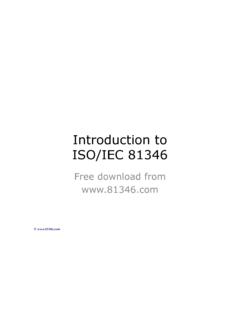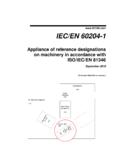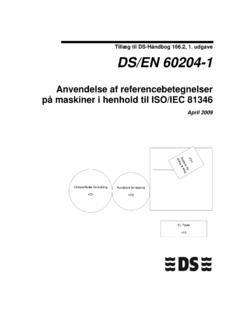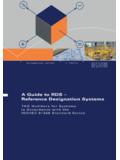Transcription of Introduction to - 81346
1 Introduction to Reference Designation System ISO/IEC 81346 Systems Engineering A/S Denmark - 2015 It s all about creating a common language semantics the meaning of words, phrases or systems ontology a list of concepts and categories in a subject area that shows the relationships between them taxonomy the scientific process of classifying things (= arranging them into groups) [Source: Oxford Advanced Learner s Dictionary, 8th edition] 2 object entity treated in a process of development, implementation, usage and disposal system set of interrelated objects considered in a defined context as a whole and separated from their environment aspect specified way of viewing an object structure part-of relation organization of relations among objects of a system describing constituency relations (consist-of / is-a-part-of) [Source: IEC/ISO 81346 -1 (2009)] 3 reference designation identifier of a specific object formed with respect to the system of which the object is a constituent, based on one or more aspects of that system [Source: IEC/ISO 81346 -1 (2009)] 4 Systems engineering Management discipline organizes the technical effort throughout the system lifecycle, including facilitating collaboration, defining workflows, and deploying development tools.
2 Technical discipline ensures that you rigorously execute a sensible development process, from concept to production to operation. Cathleen Shamieh, IBM Systems Engineering for Dummies Technical discipline ensures that you rigorously execute a sensible development process, from concept to production to operation. RDS Reference Designation System ISO/IEC 81346 standard series Designed to handle systems and their complexity Plants Machinery Building construction others Interdisciplinary naming convention 6 Historical development of RDS IEC 81346 -1:2009 IEC 61346-1:1996 IEC 60750:1983 DesignLife cycleIEC 60113-2:1971 Application domainManufacturingOperationPhase out / recycleEngineeringInstallationMaintenanc e / improvementsDiagrams with supplementary documentsTechnical documentation in generalTechnical information in generalCommon ISO/IECRDS applies in Classification 9 So you can recognize the object Aspect Sharpens the world Structure Systems and their constituents Classification + Aspect + Structure = Reference Designation Class QQC Definition space access object mainly for use by persons Preferred term Door Synonyms entrance, exit.
3 Properties Material: Glass, wood, steel, .. 10 Classification (type-of relations) Class code Class definition Class name B object intended to pick up information and provide a representation sensing object C object intended to store for subsequent retrieval storing object E object intended to provide radiation or thermal energy energizing object F object intended to protect against the effects of dangerous or undesirable conditions protecting object G object intended to provide a controllable flow generating object H object intended to transform matter(s) into other matter(s) matter converting object K object intended to treat input signals and/or information in order to provide appropriate output information processing object M object intended to provide mechanical movement or force driving object N object intended to enclose partly or fully another object covering object P object intended to provide perceptible information presenting object Q object intended to control access or flow controlling object R object intended to restrict or stabilize movement or flow limiting object S object intended to detect a manual action and provide an appropriate response manual interacting object T object intended to change energy.
4 Material or information from one state to another transforming object U object intended to hold or support other objects in a defined place or position holding object W object intended to lead from one place to another guiding object X object intended to link objects interfacing object Aspect Science MuseumNorthern HabourNew CrossCaixHospitalClinic CityUniversityThe OperaCollegeCentral Hill StreetCentral StationEast End CentralAirportAngel ParkGreen RoadCastle RoadSouth EalingTrayhillStadiumTraining HillQueens BridgeChampion StreetTeam RoadStock ExchangeHigh CourtHighgateMarketTower GatewayRDS aspects Function what an object is intended to do or what it actually does Product by which means an object does what it is intended to do Location intended or actual space of the object The product aspect is used to highlight the constructional relations (assembly) of the components of the location aspect is used to highlight the spatial relations among the components of the function aspect is used to highlight the functional relations among the components of the Aspect Function (=) Product (-) Location (+) Music keys Aspects % - = + %% -- == ++ 15 Function ID = Product ID - Location ID + Another function ID == Another product ID -- Another location ID ++ Structure part-of relations in tree like structures Object JObject MObject LObject KObject NObject RObject QObject PObject HObject GObject FObject EObject CObject BObject DObject ANumbering Separate identical objects 1 2 3 4 5 6 Syntax / + / - / %Class letter codeNumberPrefix or.
5 (See IEC 81346 -1:2009, cl. )Single-level reference designationAANN- = + % X XX Syntax Prefix Class Number 1 2 3 .. = QM 3 / - AA 1 The Reference Designation Use the syntax to identify systems and their constituents across platforms +C1+A3+B6 (or + ) Location B6 part-of A3 part-of C1 =A1=B1 (or = ) Sub system function B1 part-of system function A1 -G1-M5 (or ) Motor 5 part-of system G1 Rules of thumb 1 Do not limit your design options Never use a fixed RDS format! 2 Make sure to identify the object At least one RDS shall identify the object 3 Understand and recognise the aspect Always use an RDS prefix 4 Use the international classification Classification based on 81346 -2 works! Please visit us 23 for more information and free downloads (including today s presentation) Only complexity can reduce complexity System theoretical rule by Niklas Luhmann



